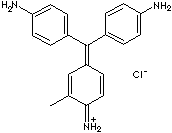PRODUCT IDENTIFICATION

C(\c1cc(c(N)cc1)C)(c1ccc(N)cc1)=C1/C=CC(=N)C=C1.Cl
CLASSIFICATION
Triarylmethane, Disinfectant
EXTRA NOTES
Overall Carcinogenic Evaluation: Group 1
Overall Carcinogenic Evaluation: Group 3
PHYSICAL AND CHEMICAL PROPERTIES
EXTERNAL LINKS & GENERAL DESCRIPTION
Wikipedia Linking - Fuchsin
Google Scholar Search - Basic Fuchsin
Drug Information Portal (U.S. National Library of Medicine) - Basic Fuchsin
PubChem Compound Summary - Basic Fuchsin
KEGG (Kyoto Encyclopedia of Genes and Genomes) - Basic Fuchsin
http://www.ebi.ac.uk/ - Basic Fuchsin
http://www.ncbi.nlm.nih.gov/ - Basic Fuchsin
http://toxnet.nlm.nih.gov/
Hazardous Substances Data Bank - Basic Fuchsin
Local:
Fuchsin is any of several red to purple dyes consisting of the salts
(hydrochloride or acetate) of rosaniline and pararosaniline. The chemical
structural body is triaminotriphenylmethane. It posses a brilliant green sheen
crystals which produce red solution when dissolved. The solution is employed in
coloring textiles and leather. It dyes animal and vegetable in nature. It is also used in the commercial preparation of
other dyes. Basic fuchsin is used to stain collagen, muscle, or mitochondria. Mitochondria
are visible when they are stained by a fluorescent dye. But nucleus and cell
membrane are not visible. In aqueous solution with alcohol, fuchsin stains gram-positive and
gram-negative bacteria reddish colors. Counterstain of blue-green background to the surrounding tissue is malachite green.
Fuchsin is an useful stain for certain slow-growing or fastidious bacteria
(Gimenez technique).
- Acid Fuchsin (acid magenta): a various mixture of sulfonated fuchsins. There are four of these compounds which have three sulfonic groups each. It is used in Andrade's indicator and in various complex stains to demonstrate collagen fibres red and in smooth muscle in contrast to collagen.
- Basic Fuchsin (basic magenta): yellow to green powder; soluble in water and alcohol; a mixture of fuchsins and magenta II; dark green powder; used for staining the tubercle bacillus, for distinguishing between coli and aerogenes bact, as an antifungal agent in Castellani's paint, as a germicide, and as a histologic stain, pH indicator.
- Methyl Violet (crystal violet; gentian violet) : a derivative of pararosaniline; dark green powder; used as an antiallergen and bactericide, acid-base indicator and for the Gram stain; the Flemming triple stain with iodine; and Newton's crystal violet-iodine technique, and in dyeing textile.
Molecular compounds of Fuchsin
|
Product |
CAS RN |
| Tris(p-aminophenyl)methanol | 467-62-9 |
| Gentian violet | 548-62-9 |
| Leucoparafuchsin | 548-61-8 |
| Parafuchsin | 569-61-9 |
| Gentian Violet B | 603-47-4 |
| Fuchsin basic | 632-99-5 |
| Pentamethylpararosaniline | 1733-13-7 |
| Acid fuchsin | 3244-88-0 |
| Rosaniline | 3248-93-9 |
| New fuchsin | 3248-91-7 |
| Carbol-Fuchsin solution | 4197-24-4 |
| Hexamethyl-p-rosaniline chloride | 8004-87-3 |
| Carbol-Fuchsin hydrochloride | 8052-17-3 |
| 4,4',4''-Trianilinotrityl alcohol | 23681-60-9 |
| Magenta II | 26261-57-4 |
|
Methyl Violet |
52080-58-7 |
| Fuchsin nitrate | 61467-64-9 |
| N,N,N',N''-Tetramethylpararosaniline | 62902-12-9 |
| N,N'-Diphenylpararosaniline hydrochloride | 68039-52-1 |
| N-Phenylpararosaniline | 68039-51-0 |
| Fuchsin phosphomolybdate | 68845-38-5 |
| N,N'-Diphenylpararosaniline | 68966-33-6 |
| N-Sulfophenylpararosaniline | 68966-37-0 |
| N-Phenylpararosaniline hydrochloride | 68966-31-4 |
| Hemofuchsin | 77536-27-7 |
| Acid Fuchsin calcium salt | 123334-10-1 |
| Platinum basic fuchsin complex | 129370-71-4 |
| Tetrachloroplatinate dianion-basic fuchsin complex | 129770-31-6 |
| N,N,N',N'-Tetramethylpararosaniline | 133502-50-8 |
APPEARANCE
DYE CONTENT
85.0% min
LOSS ON DRYING
15.0% max
0.5% max
GENERAL DESCRIPTION OF BASIC DYE
HAZARD OVERVIEW
Harmful if swallowed. Carcinogen, Target Organ Effect. Target Organs: Liver, Thyroid, Skin, Bladder, Pituitary.
GHS
PICTOGRAMS

HAZARD STATEMENTS
H350
P STATEMENTS
P201-P308 + P313
![]()
RISK PHRASES
45
SAFETY PHRASES
45-53